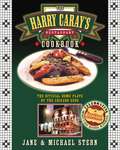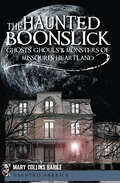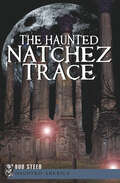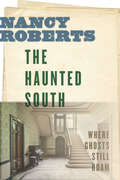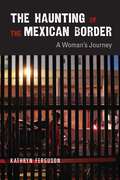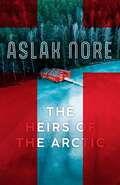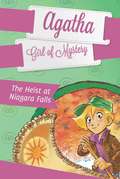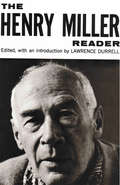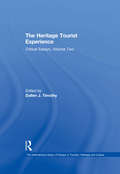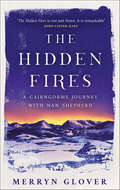- Table View
- List View
The Happy Nomad: Live with less and find what really matters
by Charlotte Bradman'Extraordinary . . . a glimpse into a future of endless possibility.'- Martin Dorey, travel writerA truly inspirational memoir for anyone who dreams of leading a different life.Vivid, self-confessional and darkly humorous, The Happy Nomad is the story of how Charlotte Bradman breaks free from her turbulent past, mounting debts and the nine-to-five treadmill, and finds a simpler way of life living full-time in her beloved campervan. Freed from the burden of a thirty-year-old boiler on the edge, temperamental ceilings that don't like heights, and letterboxes that mercilessly allow bills and arrest warrants through, Charlotte finds joy in a life lived closer to nature. Stripped back to the very basics, no longer weighed down by material possessions, she discovers the precious gift of time, enabling her to connect with both herself and the people she meets, and to re-evaluate what it truly means to thrive.The Happy Nomad is a gripping account of how one woman lost her house and found peace and contentment in her campervan home.'Proof that water in the form of driving rain, wild river, icy lake, or turquoise ocean can build back a body, mend a tattered mind, heal a broken heart, and soothe a weary soul.'- Dr Wallace J Nichols, marine biologist and author of Blue Mind
The Happy Nomad: Live with less and find what really matters
by Charlotte Bradman'Extraordinary . . . a glimpse into a future of endless possibility.'- Martin Dorey, travel writerA truly inspirational memoir for anyone who dreams of leading a different life.Vivid, self-confessional and darkly humorous, The Happy Nomad is the story of how Charlotte Bradman breaks free from her turbulent past, mounting debts and the nine-to-five treadmill, and finds a simpler way of life living full-time in her beloved campervan. Freed from the burden of a thirty-year-old boiler on the edge, temperamental ceilings that don't like heights, and letterboxes that mercilessly allow bills and arrest warrants through, Charlotte finds joy in a life lived closer to nature. Stripped back to the very basics, no longer weighed down by material possessions, she discovers the precious gift of time, enabling her to connect with both herself and the people she meets, and to re-evaluate what it truly means to thrive.The Happy Nomad is a gripping account of how one woman lost her house and found peace and contentment in her campervan home.'Proof that water in the form of driving rain, wild river, icy lake, or turquoise ocean can build back a body, mend a tattered mind, heal a broken heart, and soothe a weary soul.'- Dr Wallace J Nichols, marine biologist and author of Blue Mind
The Happy Nomad: Live with less and find what really matters
by Charlotte Bradman'Extraordinary . . . a glimpse into a future of endless possibility.'- Martin Dorey, travel writerA truly inspirational memoir for anyone who dreams of leading a different life.Vivid, self-confessional and darkly humorous, The Happy Nomad is the story of how Charlotte Bradman breaks free from her turbulent past, mounting debts and the nine-to-five treadmill, and finds a simpler way of life living full-time in her beloved campervan. Freed from the burden of a thirty-year-old boiler on the edge, temperamental ceilings that don't like heights, and letterboxes that mercilessly allow bills and arrest warrants through, Charlotte finds joy in a life lived closer to nature. Stripped back to the very basics, no longer weighed down by material possessions, she discovers the precious gift of time, enabling her to connect with both herself and the people she meets, and to re-evaluate what it truly means to thrive.The Happy Nomad is a gripping account of how one woman lost her house and found peace and contentment in her campervan home.'Proof that water in the form of driving rain, wild river, icy lake, or turquoise ocean can build back a body, mend a tattered mind, heal a broken heart, and soothe a weary soul.'- Dr Wallace J Nichols, marine biologist and author of Blue Mind
The Harry Caray's Restaurant Cookbook: The Official Home Plate of the Chicago Cubs
by Jane Stern Michael SternHarry Caray's Restaurant, "the best steakhouse in Chicago"* with "the quintessential Chicago bar"**, is named for the late, renowned baseball announcer and has been designated the Official Home Plate of the Chicago Cubs. The bar is 60'6", the exact distance from the pitcher's mound to home plate, and the restaurant houses 1,500 pieces of baseball memorabilia, including photographs, vintage newspapers, a Sammy Sosa autographed bat, and items from Stan Musial, Ernie Banks, Hank Aaron, Ted Williams, and others. Harry Caray's is just north of the Loop in one of Chicago's most architecturally significant buildings. The Harry Caray's Restaurant Cookbook is a visit to Chicago and the restaurant that serves "the best Chicken Vesuvio in the city"***. More than 150 recipes include "potent pasta, holy-cow steaks, and chicken fit for the Chairman of the Board." **** The stories, sidebars, and pictures bring back memories of baseball and Chicago. This important addition to the RoadfoodTM Cookbook series is sure to be a favorite with people in Chicagoland and throughout the country. "When you only have time to visit one restaurant in Chicago, it's got to be Harry Caray's" - David M. Lissner, Dining Chicago. * Chicago Tribune ** Jay Leno *** Chicago Tribune and ABC **** Chicago Sun Times
The Haunted Boonslick: Ghosts, Ghouls & Monsters of Missouri's Heartland (Haunted America)
by Mary Collins Barile&“A slim, riveting tome dedicated to the haunts of the Mid-Missouri region . . . [This] book is chock-full of history&” (Columbia Daily Tribune). There is some uncertainty about the exact borders of the region that surrounds the Boonslick Trail but little doubt about the palpable and unsettling presence of its history. Stir up Missourians from St. Louis to Jackson County with the mention of ghosts, and after a few minutes of demurring, you will soon have more stories than you can shake a sheet at. Attend to the haunting music of John &“Blind&” Boone or the otherworldly poetry of Patience Worth. Crouch down in Civil War battlefields, crowded taverns, or the uncomfortable saddle of a headless horse. Wend your way through Missouri&’s haunted heart: the Boonslick. Includes photos! &“The book covers a broad history of hauntings and unexplained occurrences since 1812. It is peppered with ghost stories that have very human explanations.&” —Missourian &“Mary Collins Barile gives a history of the area, and mentions that these ghost stories are ones that are unknown to outsiders, yet important to the history of the region.&” —St. Louis magazine
The Haunted History of the Ohio State Reformatory (Haunted America)
by Sherri BrakeParanormal expert Sherri Blake takes readers on a terrifying tour of Ohio&’s infamous prison, where The Shawshank Redemption was filmed. Built on the site of a Civil War camp ravaged by disease, the Ohio State Reformatory first opened in 1896 to reform young offenders but eventually grew to house the most dangerous criminals. By the time the Mansfield institution closed, the prison was hosting a thousand more prisoners than it was designed to hold in &“brutalizing and inhumane conditions.&” Within the dark corridors made famous as the backdrop for The Shawshank Redemption, ghostly presences linger, from the dungeons of solitary confinement to the West Wing showers, where a bent pipe marks the place where a prisoner hanged himself. Venture behind the walls of this notorious prison with ghost tour guide Sherri Brake to discover the history and spirits that forever haunt these halls . . . if you dare. Includes photos!
The Haunted Natchez Trace (Haunted America)
by Bud SteedTake a trip from Natchez to Nashville and discover the paranormal history along the way . . . includes photos! Stretching from Natchez, Mississippi to Nashville, Tennessee, the Natchez Trace is one of the oldest, most historically significant routes in American history. Beginning as hunting ground for natives, the Trace became the favored path back home for early settlers who floated down the Mississippi River to sell goods in Natchez. Yet the Trace was riddled with bandits, marauders, and other perils, and today troubled and tortured voices from the past still echo along the road. Travel to Grinders Stand, where famed explorer Meriwether Lewis met his untimely demise—and on to Kings Tavern, built in the late 1700s and haunted by the ghost of the innkeeper&’s mistress. This terrifying travelogue recounts these tales, and more, all lurking in the shadows of the Haunted Natchez Trace.
The Haunted South: Where Ghosts Still Roam
by Nancy RobertsThe Old South comes to supernatural life in this classic collection of chilling tales from the “custodian of the twilight zone” (Southern Living).Nancy Roberts, known as the “First Lady of American Folklore,” is a topnotch storyteller and one of the few who both write and tell their own stories. For more than two decades, Ms. Roberts has documented ghost stories and interviewed hundreds of people throughout the United States.A nationally known author of twenty-three books, Ms. Roberts began her career with a series of ghost stories written for The Charlotte Observer. Carl Sandburg sent her word that her stories were good, suggesting “they should be a book.” Since then her books have won her a certificate of commendation from the American Association for State and Local History and a nomination for the Great Western Writer’s Spur Award.The Haunted South includes tales about . . . An angel sighting in the North Carolina mountainsA poltergeist occurrence that drew trainloads of spectators to Jessup, GeorgiaA ghostly warning in Atlanta presaging a major plane crashA North Carolina tavern where unsuspecting travelers were murderedAn omen of death brought by South Carolina’s “Gray Lady”The apparition of an Alabama Railroad Robin HoodA ghost ship off North Carolina’s Outer BanksPraise for Nancy Roberts“Ghost hunter/author Nancy Roberts has put together as shivery a selection of other worldly tales as you’re likely to find anywhere . . . And whether you believe in ghosts or not, these tales are guaranteed to give you a chill, especially before you go into a dark room alone.” —Southern Living
The Haunting of Mississippi (Haunting Ser.)
by Barbara Sillery“Excellent . . . provides well-researched history as well as reports of recent unusual phenomenon” —from the author of Biloxi Memories (Southern Spirit Guide).The Hospitality State plays hosts to dozens of supernatural entities in this creeptastic guide to the other side. Chilling accounts of poltergeist activity include such landmarks as the McRaven House, where spiteful spirits smack guests without warning and an image of a Confederate soldier appears in contemporary photographs. A section on Anchuca in Vicksburg describes the vision of a woman in a fancy dress who floats through bedroom doors and the sound of dripping water without a source. Other establishments include Merrehope, King’s Tavern, and the Williams Gingerbread House.“Sucked me right in to Mississippi’s rich, haunted history. Sillery eloquently describes the settings of her stories, so I could easily visualize each of the places she writes about . . . At some points, I was scared out of my bones.” —Jackson Free Press
The Haunting of the Mexican Border: A Woman's Journey
by Kathryn FergusonThe Haunting of the Mexican Border is a woman&’s view of the violence and generosity of the border. For fifteen years beginning in the 1980s, Kathryn Ferguson made documentary films in Mexico&’s Sierra Madre. As she traveled south, she encountered people who were traveling north, and she learned that the border at which they converged was deadly. Drawing on her own experiences, this book explores how US immigration policies erode the lives of ordinary citizens on both sides of the border.
The Heart of Hospitality: Great Hotel and Restaurant Leaders Share Their Secrets
by Micah Solomon Herve HumlerSuccess in today's rapidly changing hospitality industry depends on understanding the desires of guests of all ages, from seniors and boomers to the newly dominant millennial generation of travelers. Help has arrived with a compulsively-readable new standard, The Heart of Hospitality: Great Hotel and Restaurant Leaders Share Their Secrets by Micah Solomon, with a foreword by The Ritz-Carlton Hotel Company's president and COO Herve Humler.This up-to-the-minute resource delivers the closely guarded customer experience secrets and on-trend customer service insights of today's top hoteliers, restaurateurs, and masters of hospitality management including:Four Seasons Chairman Isadore Sharp: How to build an unsinkable company cultureUnion Square Hospitality Group CEO Danny Meyer: His secrets of hiring, onboarding, training, and moreTom Colicchio (Craft Restaurants, Top Chef): How to create a customer-centric customer experience in a chef-centric restaurantVirgin Hotels CEO Raul Leal: How Virgin Hotels created its innovative, future-friendly hospitality approachRitz-Carlton President and COO Herve Humler: How to engage today's new breed of luxury travelers Double-five-star chef and hotelier Patrick O'Connell (The Inn at Little Washington) shares the secrets of creating hospitality connectionsDesigner David Rockwell on the secrets of building millennial-friendly restaurants and hotel spaces (W, Nobu, Andaz) that resonate with today's travelersRestaurateur Traci Des Jardins on building a "narcissism-free" hospitality cultureLegendary chef Eric Ripert's principles of creating a great guest experiences, simultaneously within a single dining room.The Heart of Hospitality is a hospitality management resource like no other, put together by leading customer service expert Micah Solomon. Filled with exclusive, first-hand stories and wisdom from the top professionals in the industry, The Heart of Hospitality is an essential hospitality industry resource.As Ritz-Carlton President and COO Herve Humler says in his foreword to the book, "If you want to create and sustain a level of service so memorable that it becomes an unbeatable competitive advantage, you'll find the secrets here."
The Heart of Man
by Jón Kalman StefánssonAfter coming through the blizzard that almost cost them everything, Jens and the boy are far from home, in a fishing community at the edge of the world. Taken in by the village doctor, the boy once again has the sense of being brought back from the grave. But this is a strange place, with otherworldly inhabitants, including flame-haired Álfheiður, who makes him wonder whether it is possible to love two women at once; he had believed his heart was lost to Ragnheiður, the daughter of the wealthy merchant in the village to which he must now inexorably return. Set in the awe-inspiring wilderness of the extreme north, The Heart of Man is a profound exploration of life, love and desire, written with a sublime simplicity. In this conclusion to an audacious trilogy, Stefánsson brings a poet's eye and a philosopher's insight to a tale worthy of the sagasmiths of old.
The Heart of Man
by Jón Kalman StefánssonAfter coming through the blizzard that almost cost them everything, Jens and the boy are far from home, in a fishing community at the edge of the world. Taken in by the village doctor, the boy once again has the sense of being brought back from the grave. But this is a strange place, with otherworldly inhabitants, including flame-haired Álfheiður, who makes him wonder whether it is possible to love two women at once; he had believed his heart was lost to Ragnheiður, the daughter of the wealthy merchant in the village to which he must now inexorably return. Set in the awe-inspiring wilderness of the extreme north, The Heart of Man is a profound exploration of life, love and desire, written with a sublime simplicity. In this conclusion to an audacious trilogy, Stefánsson brings a poet's eye and a philosopher's insight to a tale worthy of the sagasmiths of old.
The Heart of the Matter: Questions to Ask Your Cardiologist
by Sandra Jordan Douglas WestveerIf you're browsing through The Heart of the Matter, the threat of cardiac disease is lurking in your mind, and with good reason. Although national programs to contain this killer are highly successful and ahead of schedule, heart disease remains highly prevalent and deadly. Medical research during the last 15 years has successfully defined many treatment strategies that work, and many that don't. Your task is not to understand this mountain of information, but to know the critical questions to ask your doctor when you are in trouble. The Heart of the Matter will highlight for you the right questions to ask after your heart attack, or if you're afflicted by hypertension, high cholesterol, or heart failure. Before you need a pacemaker, defibrillator, heart surgery, or angioplasty, the right questions need to be asked, and you'll find out why they're important. Take advantage of all of the recent research and years of clinical experience by the authors in managing heart disease.
The Heartless Stone: A Journey Through the World of Diamonds, Deceit, and Desire
by Tom ZoellnerAn American Library Association Notable Book. When he proposed to his girlfriend, Tom Zoellner gave what is expected of every American man--a diamond engagement ring. But when the relationship broke apart, he was left with a used diamond that began to haunt him. His obsession carried him around the globe; from the "blood diamond" rings of Africa; to the sweltering polishing factories of India; to mines above the Arctic Circ to illegal diggings in Brazil; to the London headquarters of De Beers, the secretive global colossus that has dominated the industry for more than a century and permanently carved the phrase "A diamond is forever" on the psyche. An adventure story in the tradition of Susan Orlean's The Orchid Thief, The Heartless Stone is a voyage into the cold heart of the world's most unyielding gem.
The Heartless Stone: A Journey Through the World of Diamonds, Deceit, and Desire
by Tom ZoellnerIn 2000, Tom Zoellner purchased a diamond engagement ring and proposed. His girlfriend said, "yes" and then, suddenly, walked out of his life making Tom the owner of a used engagement ring. Instead of hitting the self-help shelves of his local bookstore, he hit the road travelling to diamond mines in Africa, Canada, India, Brazil and Russia to discover the true worth of this shining gem. He travelled to Japan to understand how diamonds were linked with engagements and delved into the history of our own American romance with the diamond ring. He gained entry to DeBeers, the London diamond merchants. He visited shopping mall jewellers with starry-eyed couples. Through all of his travels, he searched for an answer to the question "How has one stone created empires, ruined lives, inspired lust and emptied wallets throughout history?" A diamond version of Susan Orleans's The Orchid Thief, Tom Zoellner's The Heartless Stone is a journey to the cold heart of the world's most unyielding gem.
The Heavenly Ice Cream Shop: 'Possibly the best book I have ever read' Amazon reviewer
by Abby ClementsFor fans of Meet Me at Beachcomber Bay - a wonderful feel-good read from the author of Meet Me Under the Mistletoe.When Imogen and Anna unexpectedly inherit their grandmother Vivien's ice cream parlour, it turns both their lives upside-down. The Brighton shop is a seafront institution, but while it's big on charm it's critically low on customers. If the sisters don't turn things around quickly, their grandmother's legacy will disappear forever...Discover this feel-good bestseller set by the sea, perfect for fans of Jenny Oliver and Fiona Gibson. What readers are saying about Abby Clements: 'Deliciously romantic. A perfect summer read!' Miranda Dickinson'This sunshine tale of friendship, family and 99 Flakes was a pure delight from start to finish...Loved it' Victoria Fox'A summer read that is as heavenly as ice cream and leaves you hungry for more!' I Heart Books'Possibly the best book I have ever read.' Amazon reviewer
The Heavenly Ice Cream Shop: 'Possibly the best book I have ever read' Amazon reviewer
by Abby ClementsFor fans of Meet Me at Beachcomber Bay - a wonderful feel-good read from the author of Meet Me Under the Mistletoe.When Imogen and Anna unexpectedly inherit their grandmother Vivien's ice cream parlour, it turns both their lives upside-down. The Brighton shop is a seafront institution, but while it's big on charm it's critically low on customers. If the sisters don't turn things around quickly, their grandmother's legacy will disappear forever...Discover this feel-good bestseller set by the sea, perfect for fans of Jenny Oliver and Fiona Gibson.What readers are saying about Abby Clements: 'Deliciously romantic. A perfect summer read!' Miranda Dickinson'This sunshine tale of friendship, family and 99 Flakes was a pure delight from start to finish...Loved it' Victoria Fox'A summer read that is as heavenly as ice cream and leaves you hungry for more!' I Heart Books'Possibly the best book I have ever read.' Amazon reviewer
The Heirs of the Arctic: The bestselling Norwegian family drama (The Falck Saga #2)
by Aslak NoreThe Falcks are one of the most powerful families in Norway. And where there is power, there is envy and greed.December 2015. Six months after the revelations in a long-lost testament testament shook the Falck family to its core.Hans Falck, who had most to gain from the contentious will, lingers in a hospital bed in northern Norway, gravely injured in an accident. Meanwhile, Sasha Falck, who succeeded her father as the head of the family's foundation, is pushing for a research expedition to the Svalbard archipelago in the Arctic Sea. Yet there are reasons to be cautious - relations with Russia are strained, with Norway's old Cold War adversary reborn.The stakes are further raised when reports reach Sasha's ears of a foreign spy in the foundation, sparking a desperate hunt for the mole. And as the expedition nears the spectacular landscapes of the High Arctic, international tensions threaten to spill over into outright conflict - with fateful consequences for the Falck clan.The Heirs of the Arctic, the second novel in Aslak Nore's bestselling Falck Saga, traces a tale of illicit love, geopolitical cat-and-mouse games and bitter power struggles, as the fate of one powerful Norwegian family becomes emblematic of the challenges facing Europe in the new century.Translated from the Norwegian by Séan Kinsella
The Heist at Niagara Falls #4
by Stefano Turconi Sir Steve StevensonThe fabulous, jet-setting mysteries continue with hip and headstrong Agatha ready to solve the case! Agatha and her cousin Dash have been summoned to Niagara Falls. Priceless jewels have gone missing from the hotel room of a famous opera singer--it is believed to be the work of Canada's most notorious thief, Ratmusqué. Will Agatha be able to solve the mystery?
The Hen Who Sailed Around the World: A True Story
by Guirec SoudéeMeet Monique! In this true story, online phenomenon Guirec Soudée shares his adventures both unbelievable and heartwarming, sailing around the world with his brave, affectionate red hen, Monique. Monique is a highly accomplished chicken: she surfs, she skateboards, and she just crossed the world on a tiny boat with her human companion, Guirec, who helped steer. On their three-year journey, together they were unstoppable. When they became stranded in the ice off Greenland for four months, Monique, unruffled as always, kept Guirec alive with her eggs-- and they both made it home. Guirec and Monique are irresistible as unlikely comrades and friends taking on the world, and Guirec documented their journey with his remarkable, comical photographs. A deeply touching portrait of the real-life bond between animals and the humans who love them as well as a thrilling survival story, The Hen Who Sailed Around the World is an adventure for the ages.
The Henry Miller Reader (Essay Index Reprint Ser.)
by Henry Miller Lawrence DurrellA collection of works spanning the entire career of great 20th-century American writer Henry Miller, edited and introduced by Lawrence Durrell. In 1958, when Henry Miller was elected to membership in the American Institute of Arts and Letters, the citation described him as: "The veteran author of many books whose originality and richness of technique are matched by the variety and daring of his subject matter. His boldness of approach and intense curiosity concerning man and nature are unequalled in the prose literature of our times." It is most fitting that this anthology of "the best" of Henry Miller should have been assembled by one of the first among Miller’s contemporaries to recognize his genius, the eminent British writer Lawrence Durrell. Drawing material from a dozen different books Durrell has traced the main line and principal themes of the "single, endless autobiography" which is Henry Miller’s life work. "I suspect," writes Durrell in his Introduction, "that Miller’s final place will be among those towering anomalies of authorship like Whitman or Blake who have left us, not simply works of art, but a corpus of ideas which motivate and influence a whole cultural pattern." Earlier, H. L. Mencken had said, "his is one of the most beautiful prose styles today," and the late Sir Herbert Read had written that "what makes Miller distinctive among modern writers is his ability to combine, without confusion, the aesthetic and prophetic functions." Included are stories, "portraits" of persons and places, philosophical essays, and aphorisms. For each selection Miller himself prepared a brief commentary which fits the piece into its place in his life story. This framework is supplemented by a chronology from Miller’s birth in 1891 up to the spring of 1959, a bibliography, and, as an appendix, an open letter to the Supreme Court of Norway written in protest of the ban on Sexus, a part of which appears in this volume.
The Heritage Tourist Experience: Critical Essays, Volume Two (The International Library of Essays in Tourism, Heritage and Culture)
by Dallen J. TimothyThis three volume reference series provides an authoritative and comprehensive set of volumes collecting together the most influential articles and papers on tourism, heritage and culture. The papers have been selected and introduced by Dallen Timothy, one of the leading international scholars in tourism research. The second volume 'The Heritage Tourist Experience' focuses on the nature of the heritage experience, the demand for heritage, and managing visitors and their experiences. Sold individually and as a set, this series will prove an essential reference work for scholars and students in geography, tourism and heritage studies, cultural studies and beyond.
The Hero's Way: Walking With Garibaldi From Rome To Ravenna
by Tim ParksThe acclaimed author of Italian Ways returns with an exploration into Italy’s past and present—following in the footsteps of Garibaldi’s famed 250-mile journey across the Apennines. In the summer of 1849, Giuseppe Garibaldi, Italy’s legendary revolutionary, was finally forced to abandon his defense of Rome. He and his men had held the besieged city for four long months, but now it was clear that only surrender would prevent slaughter and destruction at the hands of a huge French army. Against all odds, Garibaldi was determined to turn defeat into moral victory. On the evening of July 2, riding alongside his pregnant wife, Anita, he led 4,000 hastily assembled men to continue the struggle for national independence elsewhere. Hounded by both French and Austrian armies, the garibaldini marched hundreds of miles across the Appenines, Italy’s mountainous spine, and after two months of skirmishes and adventures arrived in Ravenna with just 250 survivors. Best-selling author Tim Parks, together with his partner Eleonora, set out in the blazing summer of 2019 to follow Garibaldi and Anita’s arduous journey through the heart of Italy. In The Hero’s Way he delivers a superb travelogue that captures Garibaldi’s determination, creativity, reckless courage, and profound belief. And he provides a fascinating portrait of Italy then and now, filled with unforgettable observations of Italian life and landscape, politics, and people.
The Hidden Fires: A Cairngorms Journey with Nan Shepherd
by Merryn GloverMerryn Glover’s The Hidden Fires is not just brave, it is remarkable' – Sir John Lister-Kaye Elemental, fierce and full of wonder, the Cairngorm mountains are the high and rocky heart of Scotland. To know them would take forever, to love them demands a kind of courageous surrender. In The Hidden Fires, Merryn Glover undertakes that challenge with Nan Shepherd as companion and guiding light. Following in the footsteps and contours of The Living Mountain, she explores the same landscapes and themes as Shepherd’s seminal work. This is a journey separated by time but unified by space and purpose, a conversation between two women across nearly a century that explores how entering the life of a mountain can illuminate our own. An Australian who grew up in the Himalayas, her early experiences of the Scottish hills and weather left her cold. But gradually acclimatising and with an approach like Shepherd’s, that is more mountain wandering than mountaineering, she discovers the spark that sets the hills and herself on fire. Through Glover’s deepening encounter, the wild majesty and iridescence of the Cairngorms is revealed in this beautiful evocation of landscape, place and identity.


